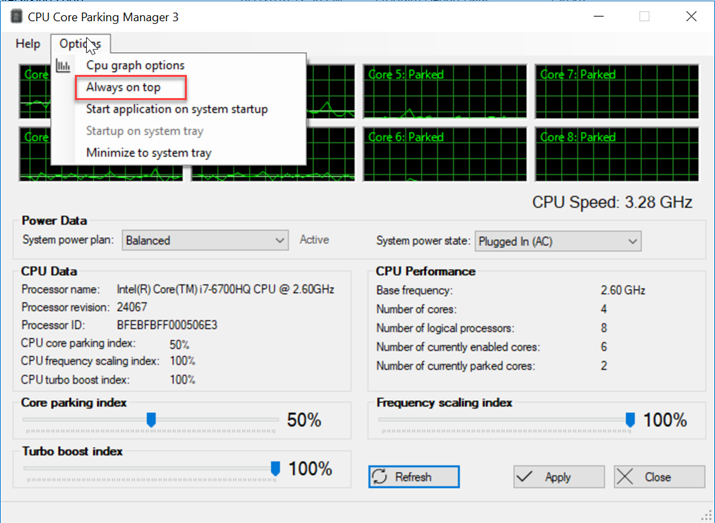CPU Parking is a low-power sleep state (C6) supported by most modern processors and operating systems. It dynamically disables CPU cores in an effort to conserve power when idle. Unfortunately, this power saving comes at a price: Latency when CPUs need unparked to execute code.
CPU core parking manager comments. Disables or enables processing cores of a computer. Review Comments (1) Questions & Answers 1 comment. Notify me of replies from. CPU core parking manager v3 nsane.forums is an interactive community. As with all such communities members are expected to behave in a certain manner.
Initially, core parking was controlled entirely by the operating system. The aggressive core parking of Windows led to a great deal of inefficiency during bursting CPU loads. Intel moved core parking control onto the chip in the Skylake generation, and AMD followed, but still the parameters of the Windows power plans are set to aggressively park CPU cores. Even the default ‘High Performance’ power plan is not immune. The new ‘Ultra Performance’ power plan copies what Bitsum did with our own ‘Bitsum Highest Performance’ power plan and finally disables core parking entirely.
ParkControl (and Process Lasso) not only let one more easily configure CPU core parking and frequency scaling, but also allow for dynamic entrance into a higher performance power plan. For instance, with Process Lasso, you can automatically enter ‘Bitsum Highest Performance’ will you start a game, then go back to ‘Balanced’ when you exit.
ParkControl has Dynamic Boost to allow you to set active and idle power plans. Process Lasso has a similar feature with its IdleSaver.
Efficacy
Cpu Core Parking Manager Download
Empirical evidence shows that disabling core parking can make a real difference in system performance. There are many factors that will determine precisely how efficacious it will be for any given system. However, generally, Windows is too aggressive in its core parking, resulting in excess latency during bursting CPU loads (the most common type).
How to Restore Defaults
Any changes you make with ParkControl are easily reverted. To restore the default power plan settings:
Cpu Core Parking Manager Download
- Click ‘Power Options’ in the ParkControl app
- Select the Power Profile you modified
- Click ‘Restore default settings for this plan’
- Repeat for all modified power plans
Changing Parking Settings Using PowerCfg.exe
You can also change these settings via Window’s Powercfg.exe. You must run this utility with elevated rights, so be sure to open an elevated console window by right-clicking ‘cmd.exe’ and selecting ‘Run as Administrator’.
Note that these commands adjust the currently active power profile. You can adjust specific ones by using their GUID, or switching to them prior to running these commands.
First, backup ALL your Power Settings by creating a dump of everything to a TXT file. It is unlikely you will ever need this, but…
To mandate 50% of available cores always remain unparked, run:
To adjust it so that only 25% of available cores remain active at all times, allowing 75% of available cores to be parked, you’d run:
‘0’ <zero> indicates to park as many CPU cores as possible.
Cpu Core Parking Manager V3
To enable maximum use of CPU Parking for the power profile you are currently using:
To disable CPU Parking completely for the power profile you are currently using, you’d want to run:
All the above configure core parking while the system is plugged into AC power. For DC (battery) power, core parking is usually forced, but to configure it you would instead use ‘-setdcvalueindex’.

APPLY New Settings, NOW!
After changing the power scheme settings for CPU Parking as desired, you then want to make the changes active by running the command:
With ParkControl, a reboot is NOT required for these changes to take effect – in contrast to direct registry edits or other core parking software.
After applying tweaks, check the Windows Resource Monitor (resmon.exe) and verify that CPU Parking is indeed as you intend.